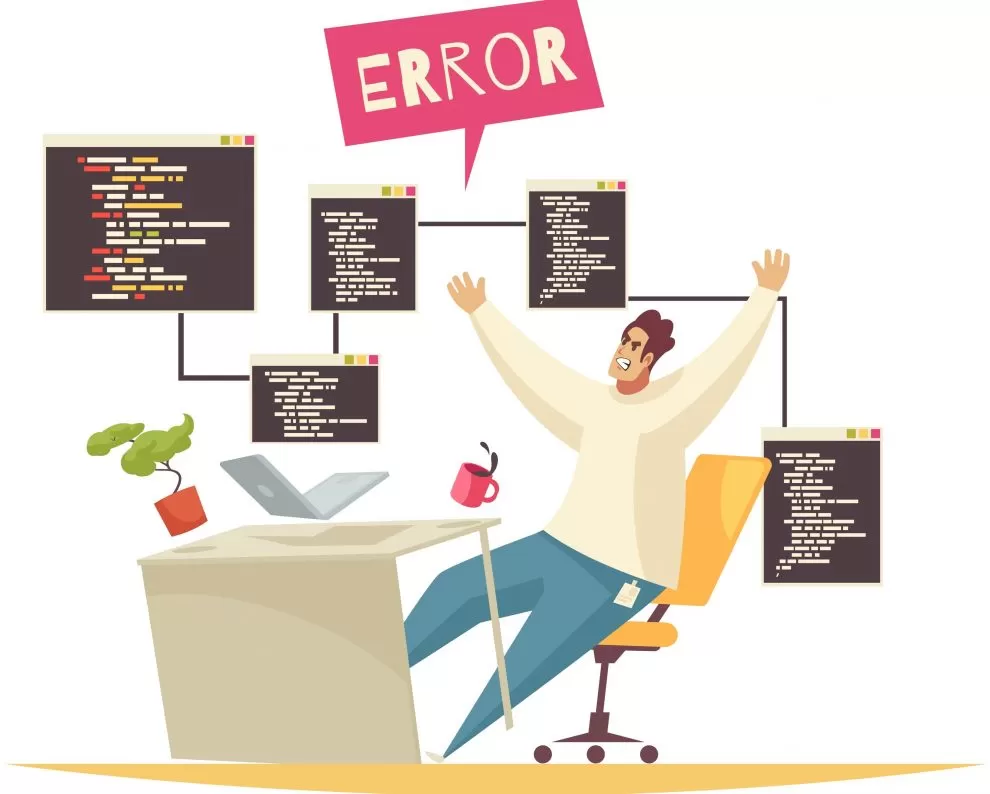Node.js has indeed revolutionized the web development landscape, providing an efficient and event-driven framework based on Google’s V8 JavaScript engine. Its non-blocking I/O and asynchronous capabilities make it a favorite among developers, enabling the creation of highly responsive applications. However, this immense power and flexibility come with a caveat: the possibility of making errors, just like any other technology. Even seasoned developers find themselves facing common Node.js Developer Mistakes. In this article, we’ll take a deep dive into these pitfalls, understanding their implications and offering valuable insights to help developers steer clear of these avoidable blunders.
1. Neglecting Error Handling
One of the most prevalent Node.js Developer Mistakes is neglecting proper error handling. When writing code, developers often prioritize building the primary functionality of the application, inadvertently overlooking the importance of robust error handling. This oversight can have significant consequences on the application’s stability, reliability, and security.
Imagine a scenario where your application interacts with external services or databases. Without adequate error handling, a small network glitch or a temporary unavailability of the service could potentially crash your entire application. Users might face cryptic error messages, or worse, the application might fail silently, leaving users confused and frustrated.
To mitigate this mistake, always incorporate comprehensive error handling mechanisms throughout your codebase. Utilize try-catch blocks to gracefully catch and handle errors. This approach ensures that even if an error occurs, your application can respond intelligently, provide meaningful error messages, and maintain a smooth user experience.
2. Blocking the Event Loop
In the asynchronous world of Node.js, blocking the event loop stands out as a significant Node.js Developer Mistake. The event loop is at the heart of Node.js, allowing the server to handle numerous concurrent connections efficiently. However, when developers inadvertently block this loop, they compromise the very essence of Node.js—its non-blocking, high-performance nature.
Blocking the event loop occurs when a piece of code takes a long time to execute, effectively halting other operations waiting in the event loop queue. Common culprits for blocking the event loop include synchronous operations like file system interactions, heavy computations, or long-running database queries.
Picture a scenario where a user makes a request to your Node.js application that involves a synchronous operation. If that operation takes an extended period to complete, it delays subsequent requests, slowing down the application’s responsiveness and defeating the purpose of using Node.js.
Also Read: Best Backend for React in 2024
3. Ignoring Memory Leaks
Memory leaks are a critical concern for any Node.js application and overlooking them is a significant Node.js Developer Mistake. A memory leak occurs when a program allocates memory for objects or data structures but fails to release them when they are no longer needed. Over time, this can lead to a steady depletion of available memory, causing performance degradation and eventually crashing the application.
In a language like JavaScript, developers are accustomed to automatic memory management through garbage collection. However, memory leaks can still occur if developers create references to objects that are never released or maintain data structures that grow indefinitely.
To address this Node.js Developer Mistake, proactively monitor your application for memory leaks using tools like Node.js’s built-in heap profiler or external tools like Chrome DevTools. Regularly analyze memory usage and identify any abnormal patterns or consistent increases in memory consumption.
Furthermore, always be diligent in managing your variables and objects. Release unused resources and avoid unnecessary object retention. By addressing memory leaks promptly, you can maintain optimal application performance and ensure a smooth user experience.
4. Overlooking Scalability
Scalability is a fundamental aspect often underestimated in the realm of Node.js Developer Mistakes. Node.js is renowned for its ability to handle a large number of concurrent connections efficiently. However, without adequately considering scalability in your application’s architecture and design, you risk facing performance issues and potential system failures under heavy loads.
When you overlook scalability, you may find that your application performs excellently during initial testing or with a small user base. Still, as the application gains popularity and the user base grows, it struggles to handle the increased traffic and demands. This can lead to slow response times, unresponsive user interfaces, and, in worst-case scenarios, application crashes.
Regularly conduct load testing to simulate high traffic scenarios and identify potential bottlenecks. Monitor your application’s performance and scalability continuously, making necessary adjustments and optimizations to accommodate your growing user base effectively. By prioritizing scalability, you set the stage for a successful and resilient Node.js application that can handle the demands of a rapidly expanding user community.
5. Not Optimizing I/O Operations
Another prevalent Node.js Developer Mistake revolves around inefficient I/O operations, which can substantially hamper your application’s performance. Poorly handled file operations, database queries, or network requests can quickly become bottlenecks, resulting in sluggish response times and an unsatisfactory user experience.
In Node.js, I/O operations are a cornerstone of many applications, and how you manage them directly impacts your application’s performance. Neglecting to optimize these operations is a detrimental oversight that can cripple the application’s efficiency.
To mitigate this mistake, always prioritize efficient handling of I/O operations. Leverage asynchronous methods to ensure that your application doesn’t get blocked while waiting for I/O tasks to complete. Implement caching mechanisms to store frequently accessed data, reducing the need for repeated I/O requests.
6. Poor Error Logging and Monitoring
Neglecting robust error logging and monitoring is a widespread Node.js Developer Mistake that can prove to be detrimental. Without comprehensive logging and monitoring mechanisms, identifying, diagnosing, and resolving errors becomes a cumbersome and challenging task.
Effective error logging is akin to leaving breadcrumbs in your application’s codebase. It helps you trace the path of execution, pinpoint potential issues, and understand the context in which errors occur. When you don’t prioritize proper error logging, you’re essentially blindfolding yourself to the inner workings of your application, making it challenging to detect and address issues.
Similarly, monitoring is equally crucial. Regularly tracking application health, performance metrics, and error rates helps you stay informed about the application’s status. Monitoring allows for proactive responses to potential problems, ensuring a smoother user experience and averting potential disasters.
To rectify this Node.js Developer Mistake, adopt a comprehensive approach to error logging and monitoring. Implement a structured and organized logging system that includes relevant contextual information, such as error messages, stack traces, timestamps, and affected components. Use logging levels to categorize and prioritize logs for easier analysis.
7. Neglecting Security Measures
Security is a paramount concern in modern software development, and overlooking security measures is a significant Node.js Developer Mistake. Failing to address security adequately can expose your application to various vulnerabilities and potential threats, jeopardizing sensitive data and user trust.
Node.js, like any other technology, is not immune to security risks. Insufficiently handled authentication, inadequate data validation, and insecure APIs are common pitfalls that can lead to security breaches. A compromised application can result in data leaks, unauthorized access, and in severe cases, legal and reputational consequences.
To mitigate this Node.js Developer Mistake, prioritize security throughout your development process. Implement strong authentication mechanisms, such as OAuth, and follow secure coding practices to protect against common vulnerabilities like cross-site scripting (XSS) and SQL injection.
8. Not Optimizing for Production
Developing an application without optimizing it for the production environment is a common Node.js Developer Mistakes. Often, during the development phase, developers work in controlled, ideal conditions that might not reflect real-world usage and traffic patterns.
What works well in a development setting may not scale efficiently or perform optimally in a production environment. Failing to fine-tune and optimize the application for production can result in decreased performance, increased response times, and potential crashes when exposed to the unpredictability and demands of a live user base.
Optimize your application by carefully fine-tuning configurations, minimizing unnecessary dependencies, and optimizing critical components of your application for performance. Utilize bundling and minification to reduce the size of your application’s assets, improving load times.
Also Read: The Best Back-End Tools for US Developers to Use in 2024
9. Failing to Keep Dependencies Updated
Dependency management is a critical aspect of any software project, and failing to keep dependencies updated is a notable Node.js Developer Mistake. Dependencies are the foundation of your application, providing essential functionality and features. However, over time, vulnerabilities in dependencies may be discovered, requiring updates to ensure a secure and robust application.
Outdated dependencies can harbor known security vulnerabilities, rendering your application susceptible to potential attacks. As security patches and updates are released, failing to keep up with them can expose your application to exploitation, compromising both user data and system integrity.
Maintain a versioning strategy for dependencies and carefully review changelogs to understand the updates’ impact on your application. Automate dependency checks as part of your continuous integration/continuous deployment (CI/CD) pipeline, ensuring timely updates.
10. Not Considering Future Maintenance
Planning for the future and considering the ease of maintenance is a crucial aspect often overlooked, constituting a Node.js Developer Mistake. Code that is hard to read, understand, or modify can hinder future maintenance efforts, increasing technical debt and impeding scalability.
In the fast-paced world of technology, software projects inevitably undergo updates, feature additions, and bug fixes. Neglecting to write maintainable and easily comprehensible code can create a tangled web that makes future modifications a daunting task. This oversight can result in delayed releases, increased costs, and frustrated development teams.
Additionally, consider adopting automated testing and continuous integration practices. Writing comprehensive test cases and ensuring code coverage allows for easier and safer modifications in the future. When a developer can confidently make changes and rely on tests to catch regressions, maintenance becomes a smoother process.
Conclusion
In the dynamic world of Node.js development, steering clear of common Node.js Developer Mistakes is crucial to creating robust, efficient, and secure applications. In this article, we’ve delved into ten prevalent mistakes often encountered by developers, understanding their implications and providing valuable insights on how to avoid them.
From overlooking error handling and blocking the event loop to neglecting memory leaks and security measures, each mistake has far-reaching consequences that can impact an application’s performance, stability, and overall user experience. By addressing these pitfalls and adopting best practices, developers can significantly enhance the quality of their Node.js projects.
Proactive error handling, efficient I/O operations, and robust memory management are essential for a smooth-running application. Emphasizing scalability, security, and optimal production performance sets the stage for an application that can handle the demands of a growing user base while maintaining security and efficiency.
FAQs
In the realm of Node.js development, steering clear of common mistakes is paramount to building robust, efficient, and secure applications. These frequently encountered pitfalls can affect an application’s performance, stability, and overall user experience. In this section, we address some of the frequently asked questions (FAQs) related to the topic “Top 10 Most Common Node.js Developer Mistakes.” From understanding these mistakes to learning how to avoid them, these FAQs aim to provide insights and guidance to developers striving for excellence in Node.js development. Let’s explore the key questions often asked and unravel their solutions to help developers navigate this dynamic landscape effectively.















